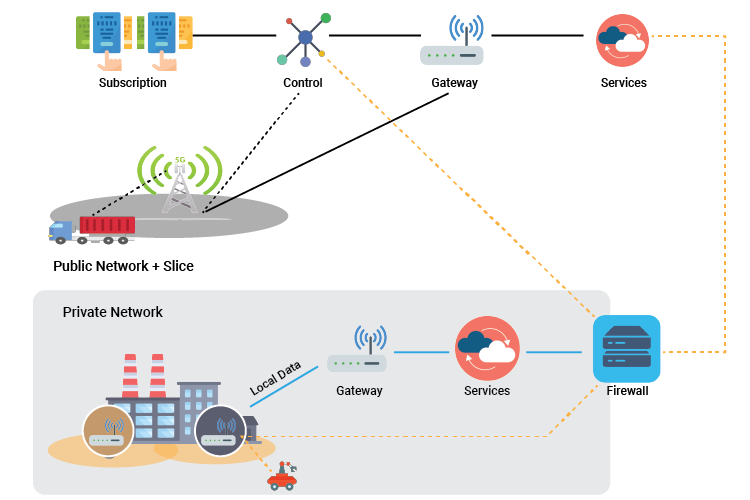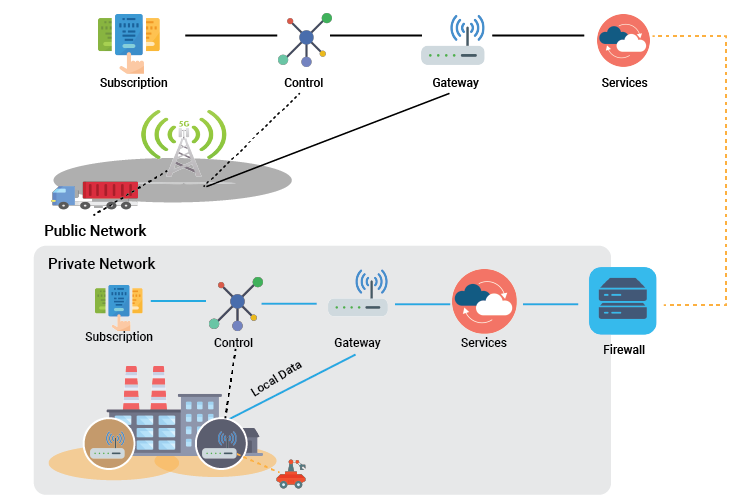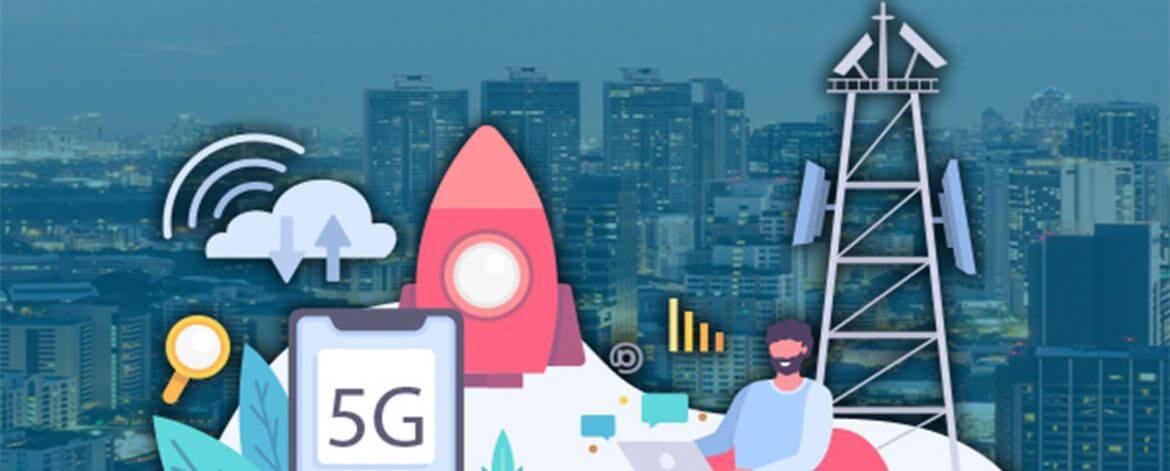A private 5G network is a network carrying all the key capabilities of 5G, however, it is isolated from the public 5G network provided by any Mobile Network Operator (MNO) or connected in a restricted manner. A private 5G network is customized in such a manner that the network infrastructure can be used only by authorized devices thus providing security, privacy and data isolation. A private network has a dedicated spectrum (licensed/unlicensed) that provides priority access to a specific set of devices to ensure the lowest latency(5msec), necessary bandwidth and assured availability.
Importance of Private 5G Network
The demand for 5G is burgeoning, gradually Wi-Fi networks are suffering from coverage, capacity, reliability and timing issues. As Wi-Fi networks use an unlicensed spectrum, there is a vulnerability impact due to users in the public domain. The private 5G network uses a dedicated spectrum and the technology offering eMBB, mMTC and URLLC features bridges the above shortcoming gaps.
Although the latest Wi-Fi 6 and Wi-Fi 6E provide a major improvement over their predecessors by offering enhanced bandwidth, less latency, high speed and security, but the 5G technology is unbeatable in terms of ultra-low latency, and precise addressability to massive amounts of devices, privacy and outdoor performance. The momentum due to aggressive investments from Telecoms, OEMs and Semicon has led to rapid developments in private 5G networks eventually simplifying the deployment and reducing the cost shortly.
Types of Private 5G Networks
- Integrated 5G Private Network: An integrated or a hybrid private 5G network operates using infrastructure (RAN/Core), spectrum or services from a public 5G network on a sharing basis, maintaining the isolation of its private devices.
- Oil and gas industries, campus networks, airports, and stadiums are some typical use cases of integrated/hybrid networks.
| Small Enterprises | Small to Medium-sized Enterprises | Larger Enterprises |
| A private 5G line from an MNO with all its services is leased out | A virtual private network is another type of integrated private network where a public 5G network is completely shared using end-to-end slicing |
A 5G network where the MEC and UPF of a public 5G network are separately deployed for private usage where private data is handled by the local network |

- Independent 5G Private Network: An independent 5G private network is built dedicatedly for a single enterprise that owns the infrastructure (RAN, Core, Edge Computing Nodes) and the wireless spectrum which are reserved for their use. It manages and controls the entire network and the devices that it connects are completely isolated from public MNO networks.
- Healthcare, Manufacturing (IIoT / TSN), and Mining are some of the typical use cases of independent 5G private networks.

Spectrum for Private 5G Networks
Basically, the 5G spectrum has an allocation in three principal ranges viz,
- Low band range comes under 1GHz
- Mid band ranges between 3.3 GHz to 3.8 GHz, 6GHz and CBRS
- High band(mmWave) range starts from 26 GHz, 28 GHz and 40 GHz range
There are three types of spectrums and the allocation of each spectrum may vary with region. Let’s understand each spectrum and its allocation in some major countries:
- Licensed Spectrum: For the private 5G network, an enterprise can purchase/lease a spectrum from the government authority or from MNOs. For critical communication requirements, a dedicated licensed spectrum can ensure the needed QoS by configuring bandwidth, speed, power etc.
- Unlicensed Spectrum: The unlicensed spectrum is free to use by anyone however it cannot promise quality service as it can be completely congested or not in use
- Shared Spectrum: The shared spectrum such as the authorized access (GAA) tier of the Citizens Broadband Radio Service (CBRS US) band can also be used for private 5G networks. However, shared licensed bands require a management system to avoid interference
| # | Country | Licensed Spectrum | Unlicensed Spectrum | Shared Spectrum |
| 1 | Denmark | 3.74 – 3. 8 GHz | – | – |
| 2 | Finland | 3.4 – 3.8 GHz | – | – |
| 3 | USA | – | n96 (5925 MHz – 7125 MHz) | n48 (3550 MHz – 3700 MHz) – CBRS |
| 4 | Germany | n77/n78 (3700 MHz – 3800 MHz) and 24.25 – 27.5 GHz | – | – |
| 5 | France | n38 (2570 MHz – 2620 MHz) | – | – |
| 6 | Netherlands | – | – | 2.3 – 2.4 GHz |
| 7 | Japan,China | n79 (4400 MHz – 5000 MHz) | – | – |
| 8 | South Korea | – | n96 (5925 MHz – 7125 MHz) | – |
| 9 | UK | n77 (3800 MHz – 4200 MHz) | – | – |
| 10 | EU | – | n96 (5900 MHz – 6400 MHz) | – |
Source: Qualcomm, 5G Technology World
Use Cases of Private 5G Networks
Private 5G networks are getting deployed actively in multiple industries and domains to enable new features and enhance the existing services. Also, it has opened up new business avenues for mobile network operators. Let’s understand some of the private 5G network use cases in detail:
Automotive Manufacturing
The automotive manufacturing industry is one of the early adopters of the private 5G network. Combining a private 5G network with the latest Industrial IoT (IIoT) standards creates an industrial-grade edge to cloud deployable solutions for the automotive industry. 5G networks offering high bandwidth, low latency and high-reliability help in connecting wireless IoT nodes and robots in a collaborative manner, enabling real-time data processing and time-critical operations. The massive amounts of data collected using a 5G network are used to drive Machine Learning (ML) platforms which continuously optimize the production and improve the quality by implementing Artificial Intelligence (AI) algorithms
Real-time Medical Imaging
Dedicated spectrum, high capacity and ultralow latency are the key factors driving the use cases of private 5G networks in the healthcare domain. Streaming of medical imaging data with added AR/VR demands high capacity data transmission without any lag. Private 5G provides a reliable communication link to allow real-time diagnosis and help time-critical surgical decisions for the medical practitioners’
Warehouse Logistics
Due to the rapid expansion of e-commerce in recent times, warehousing and related supply chain management have gained major significance. The private 5G networks offering mMTC and URLLC can help in improving the overall efficiency by bringing significant improvements in inventory management, goods transportation and security. Goods can be tracked, starting from the manufacturing unit till they reach the end consumer. The mMTC feature of 5G enables addressing to millions of closely spaced devices which are providing real-time data such as location, unit count, packaging data etc., while the URLLC feature allows tracking of rapidly moving targets. The private 5G inherently provides enhanced security and better availability leading to overall increased productivity.
Read our previous blog to know more about how 5G technology is revolutionizing industries.
Challenges Faced During 5G Private Network Deployment
- Regulatory: The 5G spectrum allocation and licensing are still not completed in many countries. This hampers the final design and deployment of several potent solutions that are ready for the market. Also, there is a significant price for the usage of a dedicated spectrum
- Cost and ROI: As mentioned above, spectrum licensing is one of the major cost factors affecting the 5G private networks. The organizations willing to deploy 5G private networks, need to invest heavily in new infrastructure and also adapt their existing devices to get enabled with 5G. The companies, therefore, critically evaluate their need and consider the return on investment before making the decision to deploy a private 5G network. Last but not least, the incumbent staff needs to be technically trained to manage and operate the network
About VOLANSYS
VOLANSYS has vast experience with the latest wireless technologies such as 5G/4G/LTE, Wi-Fi, and BLE that help the Enterprises in developing and connecting more devices at higher speeds, capacity, and low latency to upscale the performance of the devices. Our experience with wireless technologies makes it possible for our clients to have a leading edge in the very competitive market.
To know more about our experience, you can connect with our experts for consultation.

About the Author: Abhishek Ashtekar
Abhishek is working with VOLANSYS as a Technical Lead. He has 13+ years of experience working with semiconductor and embedded product companies and has expertise in architecting, designing, and developing solutions focused on the area of connectivity.









